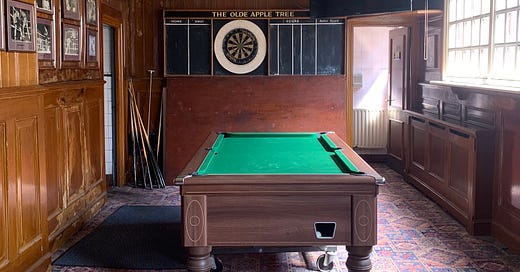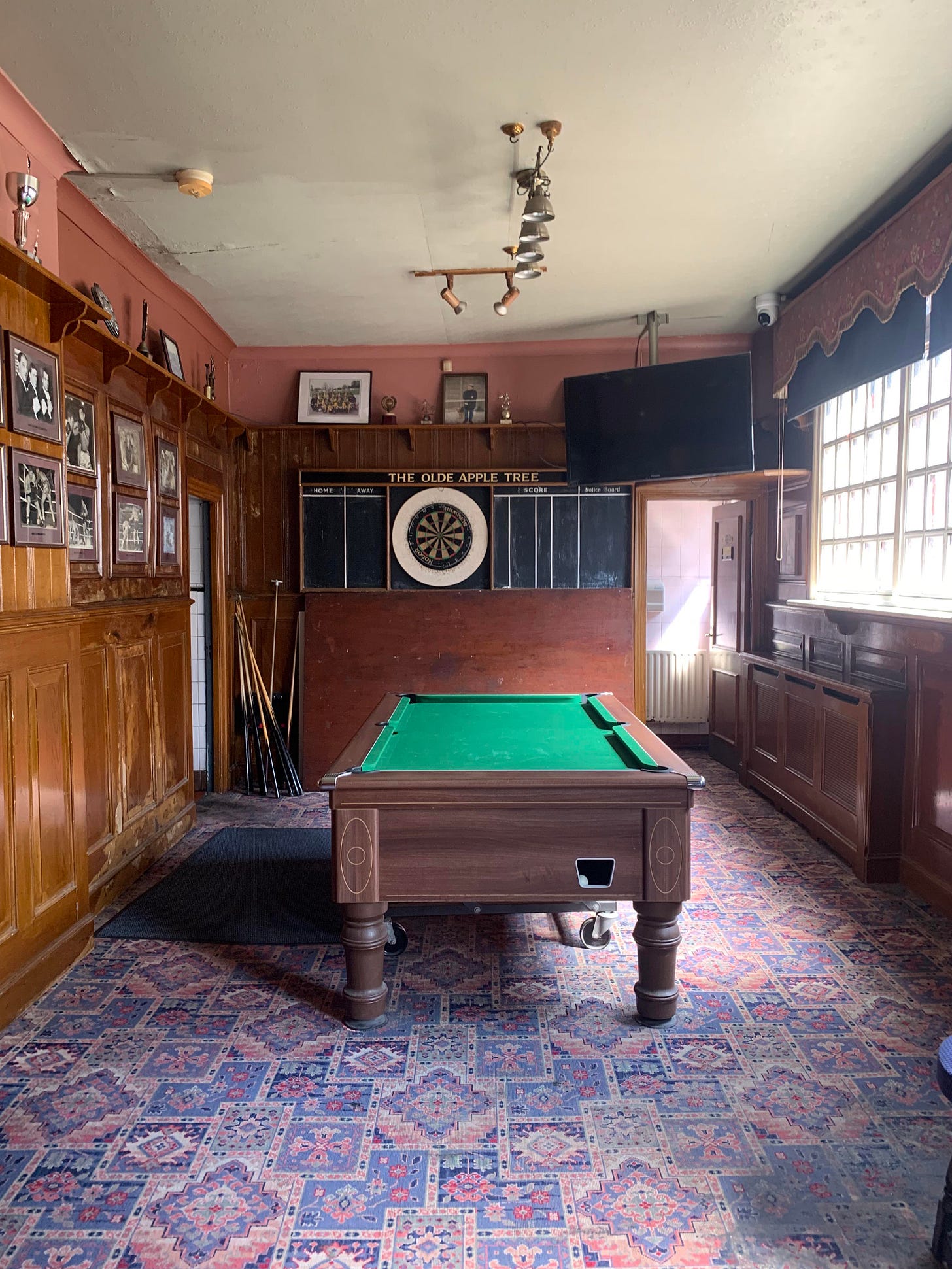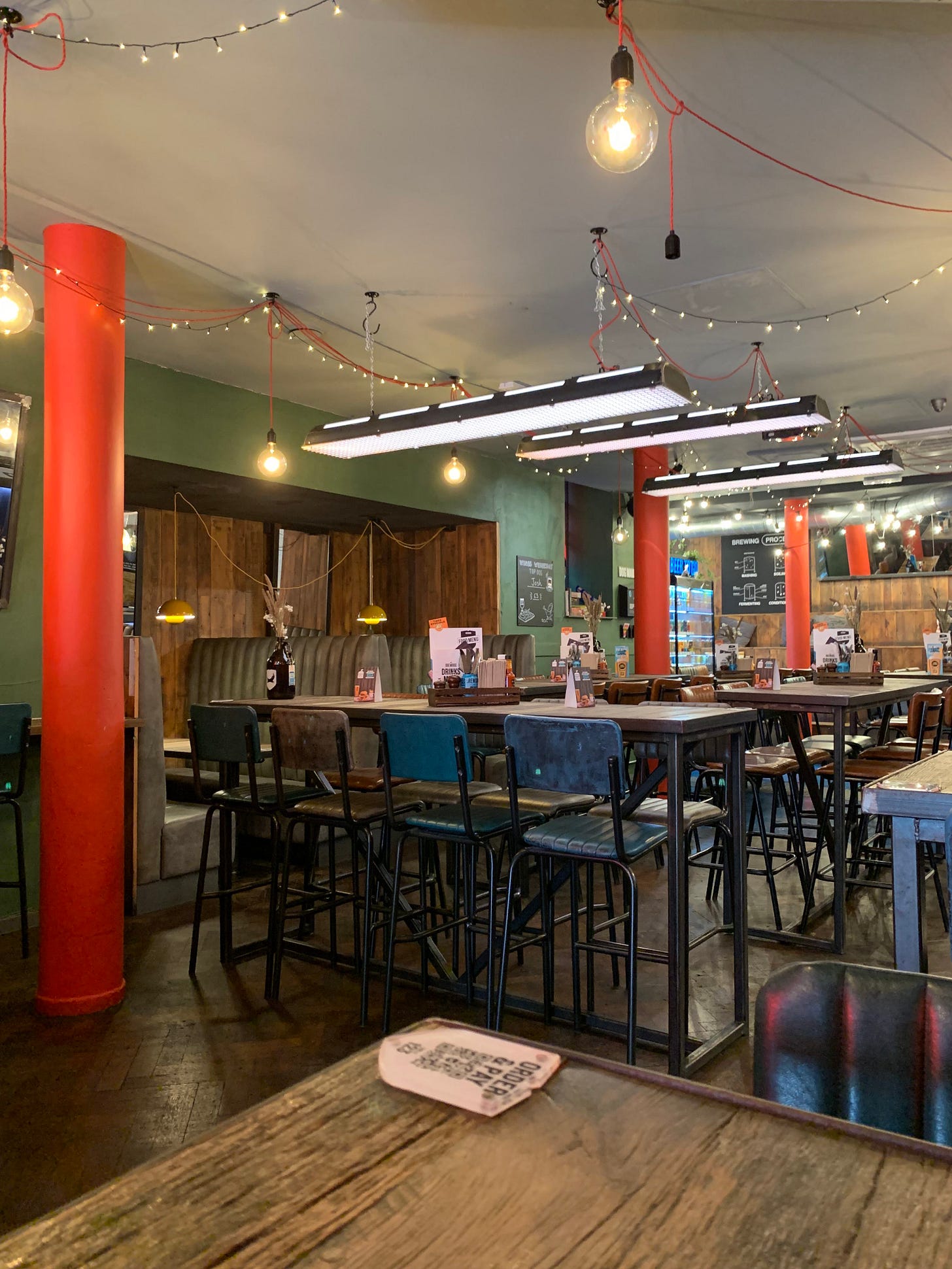Hello and welcome to Wooden City, a newsletter about London.
If you haven’t come here via @caffs_not_cafes, I'm a writer called Isaac Rangaswami and this is my Substack.
Every other week I publish an article about locally important places such as pubs, shops, restaurants and public spaces.
Wooden City is funded by its readers and paying subscribers get much more. This includes access to maps, full articles and an archive of material covering over 250 places so far.
Over the course of today, thousands of Londoners will find themselves with a pint in their hands. Some of them will be drunk inside places like BrewDog Shoreditch and Wetherspoons Victoria Station, whose furniture also exists in different configurations all over the city. In other places, like The Cock Tavern in Somers Town and Barretts Free House in Cricklewood, the barstools will be occupied by regulars who live or work nearby, beneath photos and ornaments that rest on no other shelf.
I prefer the second category. This isn’t just because these types of places have more character, but because they represent a less explicitly commercialised idea of the pub: darts, pool, no hot food, a jukebox, soft furnishings that show their age. Such features define these pubs, but none as much as the people inside.
I live near two places that contain some of these things, and one is much busier and better known than the other. The former is Skehan’s in Nunhead; the latter is The Wickham Arms in Brockley. Almost two years ago, I read a brilliant Vittles piece by Jimmy McIntosh of @londondeadpubs, about why people hate other people going to their favourite pub. It opened by considering the reaction to Time Out naming Skehan’s as London’s best pub. Even before then I’d seen Skehan’s change a lot. It’s only changed further since.
Pre-pandemic, the SE14 native who first took me to a Skehan’s lock-in told me he’d gone off it because it was so crowded, because more Goldsmith’s university students had started going there. “It changed significantly between 2019 - 2021,” someone who used to work at Skehan’s and wanted to remain anonymous told me. “Now it’s a write-off. Lots of us don’t drink there anymore.”
I still like Skehan’s, particularly earlier in the day. But I think I’d have a hard time convincing my friends to join me there for a drink on a Friday night. Crowds make pubs money, and it makes me happy to see an old-fashioned one so popular that its customers spill out onto the street. What I loved about McIntosh’s Vittles piece was the way its author was willing to turn the mirror on himself and other millennials, just as Tom Usher did when he figured out what was wrong with the vibe at Norman’s Cafe. I also agree with McIntosh’s conclusion: that gatekeeping is a thankless activity and vanishing businesses need all the help they can get. Time Out tapped him up for its latest pub ranking and I think the list is richer as a result.
Skehan’s is ranked number 15 in the magazine’s most recent list, below places such as The Olde Apple Tree in Peckham and The Army and Navy in Stoke Newington, which now holds the top spot. I think you could compare all three of these pubs and their popularity. Along with their period decor and local function, these pubs aren’t on high streets, they don’t rely on passing trade and they’re in areas that have experienced gentrification.
Not so long ago, people might only have gone to pubs like these because they lived nearby, or because a friend or colleague told them about them. In 2025, people increasingly visit pubs because someone online has said they’re good. People ask their phones “what is the best pub in X area?” including those who have only just moved there, or watch TikToks of eccentric or obnoxious personas rating the contents of their glass.
If you had to say who exactly makes pubs busier, what words would you use? Ten years ago some people might have called them “hipsters”, or maybe “yuppies” two decades before that. These are vague, outdated terms, but people reach for them when no others will do. These words have meaning, but they don’t capture the knottiness of who gets to be local as areas change and the fact that virality has eclipsed word of mouth.
This is why people turn to memes. Visual collages of the trainers people wear and the food people eat are funny because they expose showy, easily influenced types, who all have the same taste and arrive just as neighbourhoods get more expensive, but these memes are also implicated in the cultural flattening they joke about.
As with the outdated words, these images also aren’t entirely specific. They refer to people who are “young”, although that “young” can easily span people with over a decade between them. They refer to status-seekers, but don’t make precise statements about class, wealth or race.
To figure out who, if anyone, is actually ruining pubs, I started by speaking to the friendliest, most experienced pub-goer I know. His name’s Feargus, he’s the son of an Irish publican and he runs the Instagram page @londonpubmap, where at the time of writing he’d documented almost 1000 pubs (though he’s been to many more than that). When I asked Feargus why he thought places like Skehan’s, The Olde Apple Tree and The Army and Navy have become so popular, he gave me a practical answer. They’re hospitable, well-run Irish pubs, which specialise in the black stout everybody loves right now. He also mentioned their decor: “the red patterned carpet and velour banquette seating is attractive to the younger generation that didn’t experience it the first time around.”
As Feargus mentioned, one reason for this is the novelty of the old. These items of decor fascinate members of these generations because some of them have grown up going to placeless, formulaic hospitality businesses. Not just chains, but independent bars, cafes and restaurants that mimic the same superficial aesthetics. For those people, the local and the idiosyncratic, even the idea of regular customers, are just as astonishing as faded carpets and velour banquettes.
Through a blend of publicity and people saying they’re great, local pubs become destinations. Social media fuels this phenomenon, as do all the lists, in turn published by magazines that are increasingly reliant on social media. If nothing else, these processes prove that if somewhere is shown to promise quality and character, the people being promised it will travel to find out.
But these pubs don’t enter some new, no-place “destination” part of London, with extra space for the new visitors. They stay in the buildings and neighbourhoods that housed and nourished them when fewer people knew about them, and which now have to meet the new demand. So do these visitors destroy their destinations in the process? Is their popularity as simple as pouring good stout and being Irish, when so many similarly hospitable pubs across the city with those attributes haven’t blown up?





